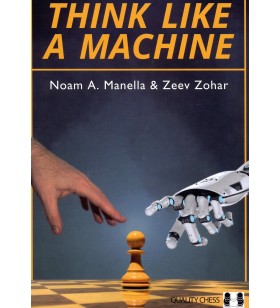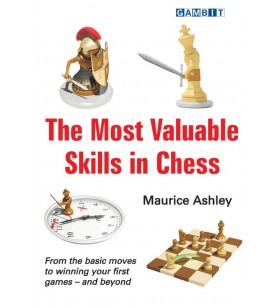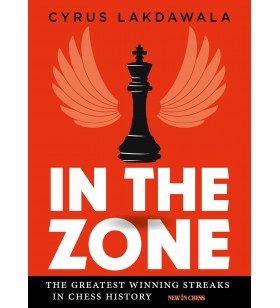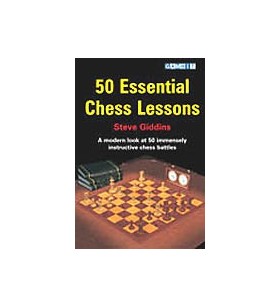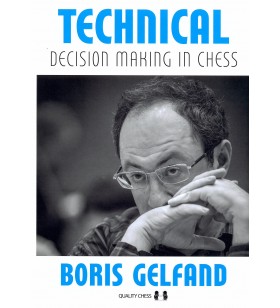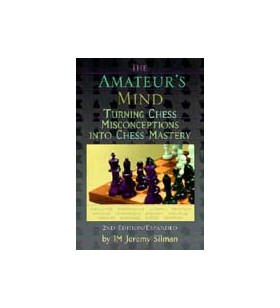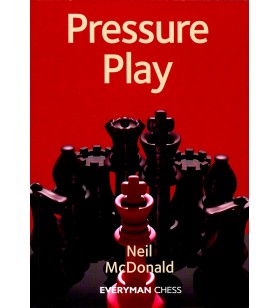- SCHAAK
- DENKSPELLEN
- GO
- BRIDGE, TAROT & KAARTEN
- POKER & CASINO
- PUZZLES & BRAINBREKERS
- DARTS
RIZZITANO - Understanding your Chess
 Livraison sous 48 heures via Bpost*
Livraison sous 48 heures via Bpost*
Gratis levering vanaf €69 (België, Frankrijk, Nederland, Luxemburg, Duitsland)
 U kunt uw bestelling annuleren
U kunt uw bestelling annuleren
Veertien dagen lang!
 Beveiligde betalingen
Beveiligde betalingen
Alle betaalkaarten geaccepteerd.
16 ander product
EINGORN - Decision -Making at the Chessboard
Zohar & Manella - Think Like a Machine
With the ascent of computer technology, humans have a chance to develop their thinking process based on hard evidence. Think Like a Machine explores human limitations and proposes new avenues for human thinking, inspired by computer engines.
In positions taken almost exclusively from modern tournament play, the authors present jaw-dropping continuations which humans struggle to find, not due to lower human computing power, due to conceptual and perceptual limitations. In this book these “crazy” moves are analysed and categorised. If you want to expand your chess imagination, understanding and intuition, Think Like a Machine is the book is for you.
Think Like A Machine is the second chess book co-written by Noam Manella and Zeev Zohar. Manella is a digital and Social Networks Researcher; Zohar is an accountant and businessman. Their previous book, Play Unconventional Chess and Win, was a highlight in chess publishing in 2014.
Gormally - Tournament Battle Plan
Books on how to improve your results over the board have been written before but in these changing times when chess has propelled onto the public consciousness, an update is badly needed. Grandmaster Daniel Gormally uses his 25+ years of experience to take the readers through the fires of the tournament cauldron, while illustrating some of his battles with the best players in England.
Along the way he tackles how to approach online play, an increasingly important issue as this form of chess has increased in popularity. Do you need a coach ? Will streamers relly help you to improve ? And should you turn off your computer ? Gormally emphasizes the importance of independent analysis in enabling the player to make progress and explains how he himself suffered in his results due to an over-reliance in chess engines.
And then there is the nitty gritty of tournament play itself. Gormally grapples with subjects that aren't covered in normal tournament books, from what hotels you should choose, to what kind of diet you need to follow, while also concluding that he lacks the awesome physical fitness of the Norwegian chess god Magnus Carlsen.
It all culminates in an explosive Hastings diary, where the author uses his acerbic wit to pull apart the vagaries of preparing for international competition in an account that verges on comic-tragic. 348 pages
Lisitsin - Key elements of chess tactics
Georgy Lisitsin (1909-72) was a respected Soviet master, theoretician and writer. In 1958 he published a revised edition of his most ambitious work, entitled Strategy and Tactics of Chess, which became one of the most legendary manuals in the Soviet chess school, and no doubt one of the books that motivated the young Bobby Fischer to learn Russian.
Lisitsin broke down Strategy and Tactics into their key constituent elements, enabling players of all levels to study chess systematically, learning from carefully selected game fragments and studies. Key Elements of Chess Tactics and its companion volume Key Elements of Chess Strategy are the first ever complete English translations of Lisitsin’s classic.
In Key Elements of Chess Tactics, Lisitsin illustrates key tactical concepts such as pinning, discovered attacks and checks, deflection, interference and many more, building a foundation before moving on to more complex and beautiful tactical themes. Hardcover 392 pages
GIDDINS - 50 Essential Chess Lessons
Gelfand - Technical Deicison Making in Chess
In Technical Decision Making in Chess former World Championship Challenger Boris Gelfand discusses his path to decision making in endgames and positions where one side possesses a structural or material advantage.
SILMAN - The Amateur's Mind
This book takes the student on a journey through his own mind and returns him to the chess board with a wealth of new-found knowledge and the promise of a significant gain in strength. Most amateurs possess erroneous thinking processes that remain with them throughout their chess lives. These flaws in their mental armour result in stinging defeats and painful reversals. Books can be bought and studied, lessons can be taken -- but in the end, these elusive problems always prove to be extremely difficult to eradicate. Seeking a solution to this dilemma, the author wrote down the thoughts of his students while they played actual games, analysed them, and catalogued the most common misconceptions that arose. This second edition greatly expands on the information contained in the popular first edition. 442 pages
YUSUPOV - Build up your chess vol. 3
Sous-titré ' Mastery ', ce qui est à la fois tout et ne rien dire De fait, on trouvera dans ce troisième (et dernier) tome les sujets les plus variés, de la stratégie à la tactique et de l'ouverture à la finale. Comme dans les précédents volumes, le gros intérêt de l'ouvrage réside dans l'abondance du matériel présenté : 12 exercices par chapitre, multipliés par 24 chapitres, cela fait de quoi s'occuper un moment. Profitable, forcément
McDonald - Pressure Play
Pressure Play by Neil McDonald. Have you ever been tortured at the chessboard? If so, then you have probably been a victim of pressure play.
Elite players are brilliant exponents of pressure play. In situations where they have either a tiny advantage or no advantage at all they are highly adept at constantly setting problems for their unfortunate opponents. The position on the board may appear lifeless but they can probe and find plans and regroupings that will constantly ask their opponents difficult questions. These can be countered only by continual alert and accurate defence and we all know how difficult and wearing that can be.
The arch exponent of pressure play is world champion Magnus Carlsen. Carlsen is superb in this area of the game and consistently defeats world class opposition from simplified positions where he has no advantage whatsoever. How does he do it?
In this book, the highly experienced author and coach Neil McDonald analyses the finest examples of pressure play. In doing so he teases out the fundamental concepts that enable players like Carlsen to torture their opponents mercilessly.
- Paralyse the enemy pieces.
- Target the weakest squares on the board.
- Increase and exploit a space advantage.
Master pressure play and it will be your opponent on the rack, not you.
352 bladen

 Français
Français Nederlands
Nederlands English
English


